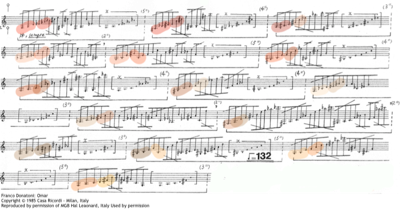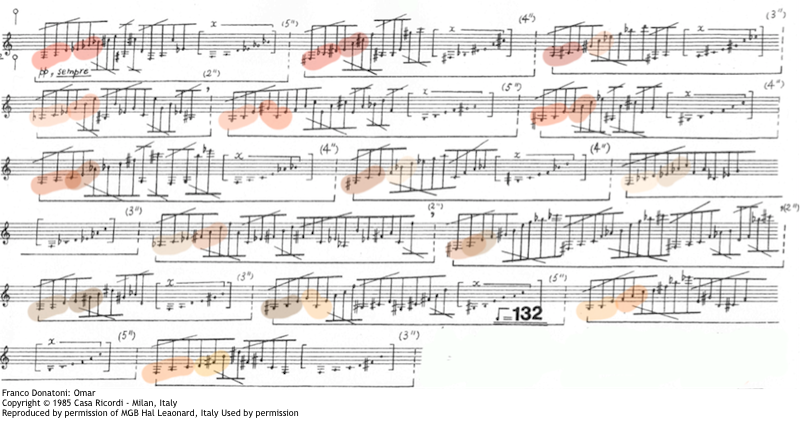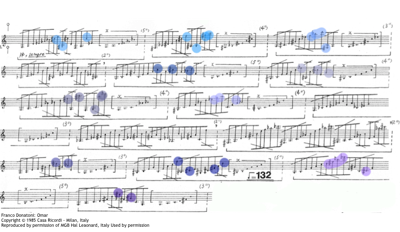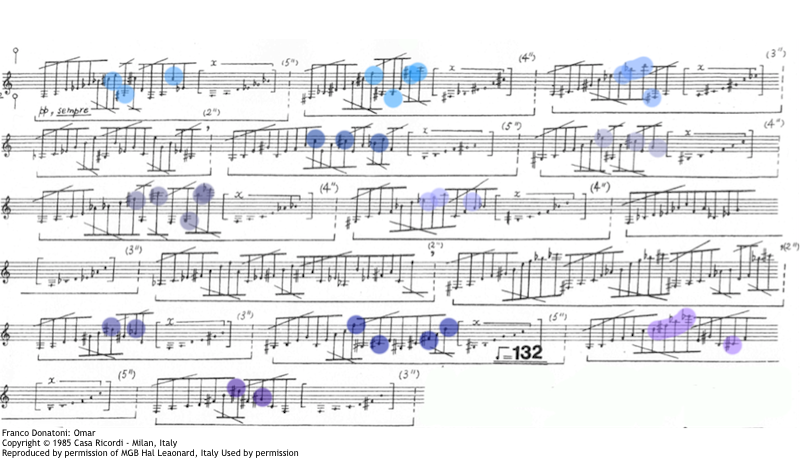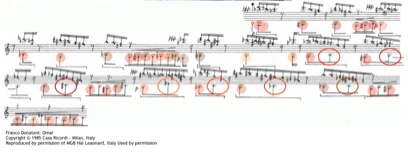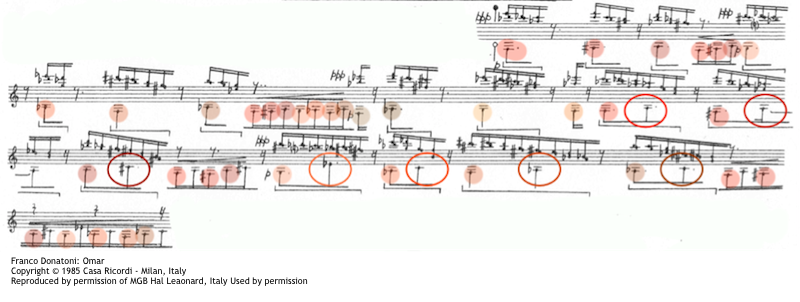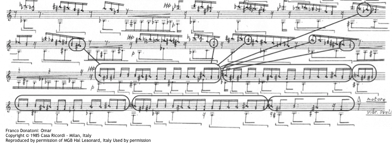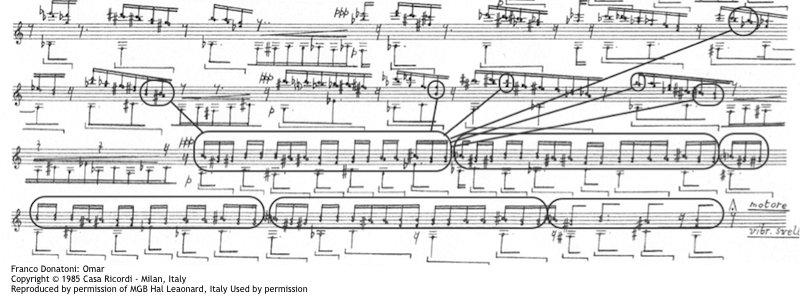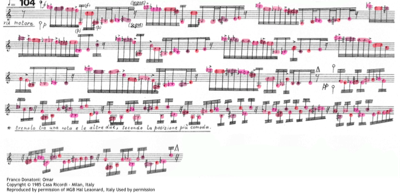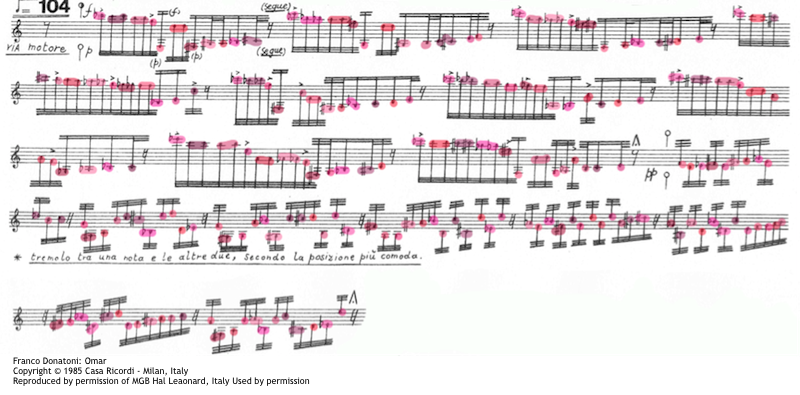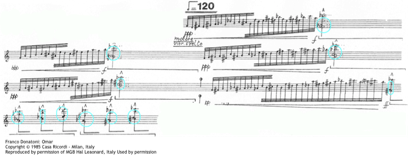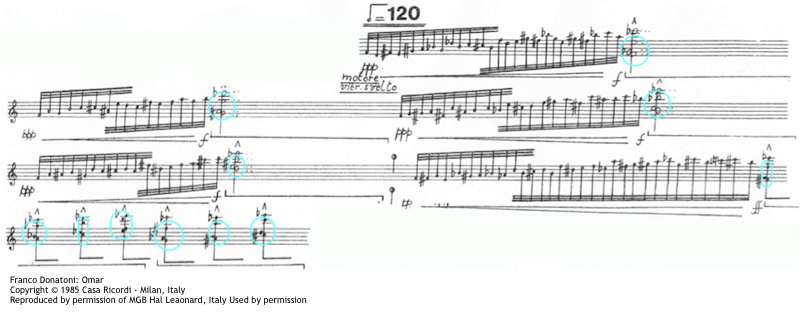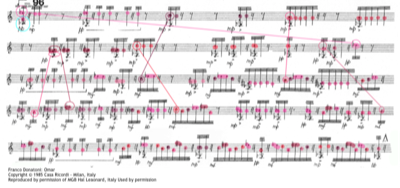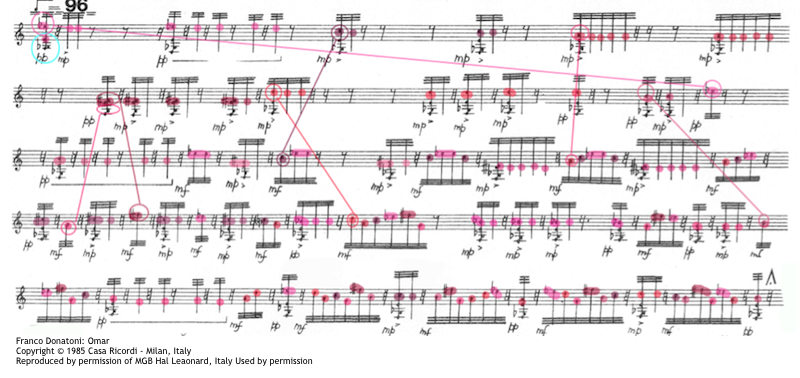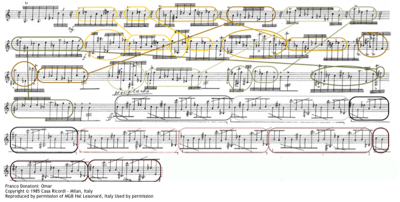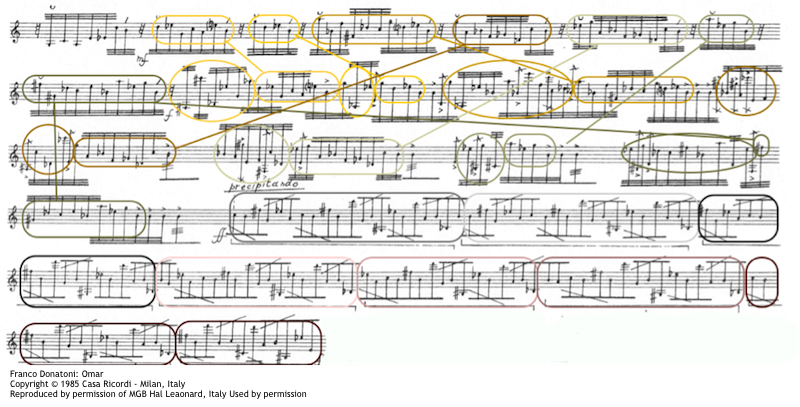Improving the practice and performance of contemporary music
A number of filters and panels used in part I return in part II of Omar. The main difference in the second part is that the processing proceeds in a less chronological way. The basic material, which appears as a panel, is taken from the section with tempo 104 in part I of Omar. The processing of this material is worked out in three ways:
- Filters used in part I of Omar
- Literal repetition of the material
- Serial processing
Opening with arpeggio's: time marked in seconds
Every arpeggio group in the first section of part II of Omar contains the triads of tempo 104 in part I of Omar. They are literally copied as a panel into this part. The extension of these chords is mostly the next triad appearing in tempo 104, which creates a harmonization between the triads and some new material. An open pedal is applied to every arpeggio. In this ‘cluster’, the performer needs to filter out a selection of notes, which creates new sound aggregates.
The difficulties about this sequence are the dynamics and the speed. To cope with these, it is recommended to practice all the pp-slurs as dead strokes, involving a lot of arm muscles. In this way, you “over practice”, so the difficult element becomes something which is easier to execute when played properly. Additionally, the same technique can be used at tempo 155 in Part I: you can practice all the slurs backwards as well. This will enhance the muscle memory in your fingers and arms. For the pedaling, the focus should be on the effectiveness of the dampening action. Be certain ALL the sound is gone. Also make sure there are no extraneous noises, and that the actual dampening action is not heard.
Sound aggregates and bassnotes: T° 132
The second section with tempo 132 applies two processes at the same time, spread out between both hands of the performer. The upper voice copies the sound aggregates of the opening section as a panel. The applied filter classifies the notes into dyads and enhances them by mirroring them around the last note - a filter taken from part I of Omar in the section with tempo 155. The lower voice consists of the first bass note of every arpeggio in the opening section. These bass notes are enhanced further by mirroring the interval upwards and by repetition. The combination of the two voices once again has a centripetal movement which also appears in the opening section of part I.
Further on in the same section with tempo 132, a new filter appears: every note that is combined with a pitch class 11 (the note B) builds up the right hand ostinato. The left hand contains the lower voice of the previous section that repeats itself literally as a panel.
In this part the focus should be on the independence of the two hands and “melodies”. For the muscle action, the lower part can be played fluid and with a round sound, the higher part should be much more biting and rigid. To make the upper part more reliable, it’s advised to play everything here on the far inner edges of the bars. In this way, the changes between the dyads will take much less effort. In the ostinato part, the two separate ostinati should be as independent as possible, as if two players are playing at the same.
T°76: chromatic clusters and rolls
The speed of the motor is crucial here to make the part work, it should be chosen so the speed of the rolls blends well into the vibrato of the instrument. For the fast slurs the same technique can be applied like before in Part I tempo 155: they can be practised forward and backwards, to enhance the muscle memory in fingers and arms.
Dodecaphonic series: T° 104
The section with tempo 104 in part II of Omar uses material almost exclusively from a dodecaphonic series derived from the second arpeggio with a length of 2 seconds in the opening section. A full chromatic octave appears clearly for the first time at this moment in the composition. A single phrase in the section with tempo 104 quite often contains all twelve tones. All the groups emerge from an Eb6. The lower voice of the first part of this section appears literally as the upper voice of the second part.
The biggest difficulties in this section are the occasionally large intervals in the upper voice of the first part of this tempo. To tackle this problem, it is advised to practice this passage very slowly, yet at the same time moving very fast from one bar to another. In this way, your arms will “know where to go” by themselves once the tempo gets faster.
Ascending melodies, chords, rolls and ornamentations: T° 120
In the section with tempo 120, the beginning of every note-group with an ascending melody stems from the beginning of the groups in the second part of the section with tempo 104. The treatment of the note Eb6 is also significant:
- In every of the first four groups, this note is missing.
- The 11 chromatic cluster chords are always constructed around this note.
An ostinato in rolls is created within the second part of this section using the cluster F4-Gb4. Each cluster is preceded with a different ornamentation. Similar clusters are also present in the long chords in the first section.
The same problem is present here as in the above tempo 104, but now with the large end-chords. It’s advised to practice slowly so the position of the chords will become something natural when played in tempo. A second problem in this part is the fast tremolos around F4-Gb4. These should be performed extremely fast so that the actual action of the roll is not heard. It should sound as a continuous cluster as opposed to a classic percussion roll.
Chords and interjections: T° 96
These cluster chords form the basis of the section with tempo 96. Only the top note has a descending character. The succession of intervals contained in this passage has a clear diminished feeling, which is reminiscent of the dodecaphonic treatment in this part. Donatoni interjects a growing group of notes between the chords that expands from one to six notes. These interjections follow the same trajectory as the top notes of the cluster chords in this part.
As in tempo 132, the goal here is to obtain a certain polyphony, this time not between both hands, but between the interjected notes and the chords. Make sure the chords are always played in the same stiff way and the interjected notes remain fluid and melodious. Additionally, it is ideal to remain highly meticulous in performing all of the marked dynamics.
Further development of the dodecaphonic series: T° 126
The dodecaphonic element is further explored in the final part with tempo 126. This section contains literal repetitions and identical treatment of the chromatic material based on the development in the section with T° 96. A sort of stretto process starts at the Precipitando pattern, filtering out the beginning notes for each repetition. The end is a final summing up of the dodecaphonic material.
Technically the most demanding part, this section should be practiced very precisely because every note, as small as it may seem, counts. Pay close attention to the build-up in dynamics and density and do not “over speed” this part, so that you reserve some energy for the end.
